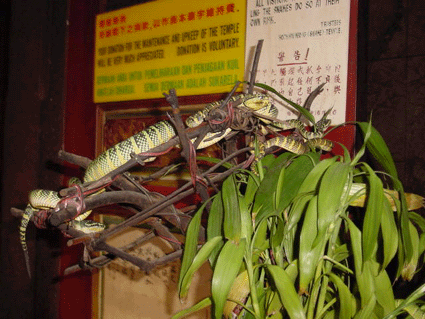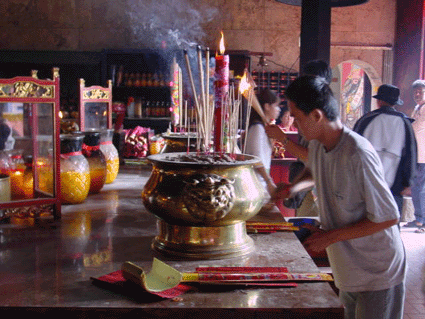"The fort was built on the site of Sir Francis Light's historic landing in 1786. Originally a wooden stockade, it was replaced with a stone and brick structure built by convict labour in 1804."
IntroductionFort Cornwallis - named after the Governor-General in Bengal, Charles Cornwallis – is one of the most interesting historical landmarks in
George Town, located close to the Esplanade, next to the Victoria Memorial Clock.
The fort's walls, roughly 10 feet high, are laid out in star-like formation. A stroll along the perimeters takes roughly 10 minutes. Inside the fort, one can still see some of the original structures built over a century ago, including a chapel, prison cells, which were once used as barracks, a munitions storage area, a harbour light once used to signal incoming ships, the original flagstaff and several old bronze canons, one of which is a Dutch canon called the Seri Rambai, dated 1603. An interesting note about the Seri Rambai - some locals believe that this particular canon can have a positive effect on a woman's fertility.
Today, this privately managed historical site is popular among visitors, equipped with a tourist information kiosk, cafe, an open-air amphitheatre, a history gallery, a souvenir centre as well as guides who can take you around the fort grounds and provide you with a glimpse of the fort's history.
Opening hours for Fort Cornwallis is from 8.30am to 6.30pm daily and the admission fees are RM3.00 for adults and RM2.00 for children below 12 years old.
HistoryOne of the earliest structures in Pulau Pinang, Fort Cornwallis was erected in 1786, not long after he acquired Pulau Pinang for the East India Company, from the Sultan of Kedah. The site where the fort was built is actually the first place where Light disembarked from his ship in 1768. Fort Cornwallis was originally built of nibong palms, but was replaced in 1804 with a sturdier stone and brick structure.
Although built for defense by design, throughout its existence, Fort Cornwallis served more as an administrative centre for the British, having survived without much threat of enemy attacks. Fort Cornwallis was once surrounded with a moat roughly 9m wide and 2m deep. Along the perimeters of the fort's wall, several canon bays were strategically placed overlooking the harbour in the north and the port activities along the eastern waterfront. In the 1920's due to a malaria outbreak in the area, the moat surrounding Fort Cornwallis was filled in.
The chapel located on the south-west corner of the fort is the first chapel ever built on Penang island and was used by the British and Europeans living there. The first-ever recorded service, however was in 1799 when John Timmers wedded Martina Rozells, the widow of Francis Light.
Travel AdviceFort Cornwallis offers the service of friendly and knowledgeable tour guides, dressed up in smart, red colonial soldier outfits, who can give you a quick and insightful tour of the fort grounds for a small fee. Without the aid of a guidebook or background knowledge of Fort Cornwallis' history, engaging these guides to take you around will be well worth the money!
For more information,
please contact:
Fort Cornwallis
Jalan Tun Syed Sheh Barakbah
10200 Georgetown, Penang
Tel: +604-2610260 / 261
Fax: +604-2610260
Additional Picture
1) This cannon was presented to the Sultan of Johor by the Dutch. However, it was given to the Acheen and installed at Kuala Selangor. Finally, this cannon was seized by the British and installed here in 1871.
Yea...when you stand by the side of this BIG CANNON, you can imagine those ship attacking from the sea and you are ready to shot !! BanGgg BanGg ~
2) The statue of Francis Light, modelled after his son was relocated from the Penang State Museum to the grounds of Fort Cornwallis. The status now overlooks the fort and it holds a great heritage treasure in the heart of Georgetown.

Ahhh, this is the fella whom stay in my classroom ?? Now i see you but you don't see me!!! He wear so thick, no wonder the room got 7 windows....

 Besides the impressive reclining Buddha, you can find many other smaller shrines of Buddha, and Thai deities. There is also series of painted images portraying story of the Lord Gautama Buddha. The floor of the temple is laid with tiles of lotus patterns - lotus is a symbol in Buddhism.
Besides the impressive reclining Buddha, you can find many other smaller shrines of Buddha, and Thai deities. There is also series of painted images portraying story of the Lord Gautama Buddha. The floor of the temple is laid with tiles of lotus patterns - lotus is a symbol in Buddhism. Admission to the Wat Chayamangkalaram temple is free, but do remember to remove your shoes before entering the temple grounds.
Admission to the Wat Chayamangkalaram temple is free, but do remember to remove your shoes before entering the temple grounds.
 Located directly across from Penang, Jerejak Resort and Spa is a wonderful stopover when you visit the Northern hub of Malaysia.
Located directly across from Penang, Jerejak Resort and Spa is a wonderful stopover when you visit the Northern hub of Malaysia. 
 Probably the only one of its kind in the world. The temple honours a resident named Chor Soo Kong, who had healing powers. He was a Buddhist monk, who moved to Penang. Some devotees from as far away as Singapore and Taiwan come to pray in the temple on Chor Soo Kong's birthday (the sixth day of the first lunar month). The temple was built in about 1850 and is dedicated to Char Soo Kong. The statue of the deified healer was brought to Penang by a monk from China. The legend is that this pious monk gave shelter to the snakes of the jungle; when the temple was completed, the snakes moved
Probably the only one of its kind in the world. The temple honours a resident named Chor Soo Kong, who had healing powers. He was a Buddhist monk, who moved to Penang. Some devotees from as far away as Singapore and Taiwan come to pray in the temple on Chor Soo Kong's birthday (the sixth day of the first lunar month). The temple was built in about 1850 and is dedicated to Char Soo Kong. The statue of the deified healer was brought to Penang by a monk from China. The legend is that this pious monk gave shelter to the snakes of the jungle; when the temple was completed, the snakes moved








 Thaipusam Festival in Penang is one of the major Hindu festivals, which is celebrated by thousands of devotes of Malaysia each year. This festival of Penang in Malaysia is celebrated on a full moon day in the tenth Tamil month either in January or in February. Observing the consecration of Hindu deity, Lord Murugan, Thaipusam Festival celebrates the day when Lord Siva's wife, Parvathi, gifted her son, Murugan, the weapon to defeat three demons.
Thaipusam Festival in Penang is one of the major Hindu festivals, which is celebrated by thousands of devotes of Malaysia each year. This festival of Penang in Malaysia is celebrated on a full moon day in the tenth Tamil month either in January or in February. Observing the consecration of Hindu deity, Lord Murugan, Thaipusam Festival celebrates the day when Lord Siva's wife, Parvathi, gifted her son, Murugan, the weapon to defeat three demons. 





















